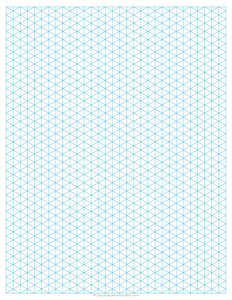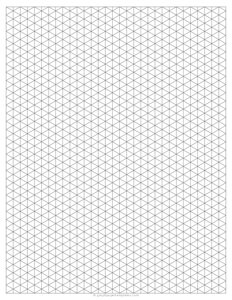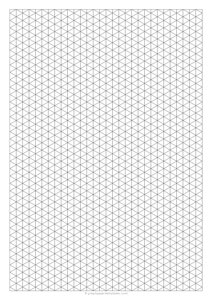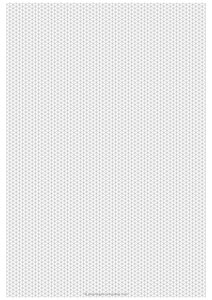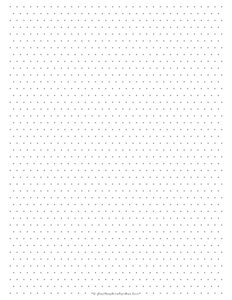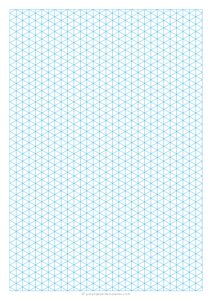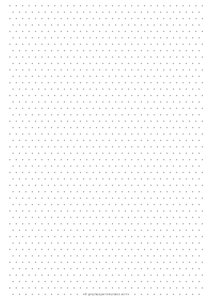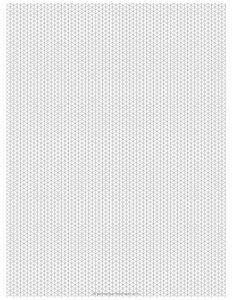Isometric Graph Paper
Our collection of isometric graph paper templates will help you work on your projects with confidence, precision, and a three-dimensional perspective.
Whether you're an architect visualizing a structure, an engineer planning technical details, or a designer working on isometric projections, our collection provides the tools you need for precise and proportionate drawings.
Showing 1-13 of 13 records
3D Isometric Graph Paper (Blue)
3D Isometric Graph Paper, with lines at 60 degrees and blue in color. This type of graph paper printable can be used to create three-dimensional images. The lines on the paper are arranged at 60-degree angles, which gives the paper a three-dimensional appearance.
view detailscategory: 3D Graph , Isometric
1/2" inch Isometric Graph Paper
Isometric graph paper is a graph paper with each line forming a 60-degree angle. It creates a 3D effect and can be used for isometric illustrations or designs. Download and print today!
view detailscategory: Isometric , 3D Graph
Isometric Dot Paper (5mm)
Isometric dot paper is a type of graph paper that uses dots instead of lines to create an isometric grid. This grid is used for drawing three-dimensional objects, such as cubes, pyramids, and spheres.
view detailscategory: Isometric , 3D Graph
Isometric Dot Paper (1 cm)
Isometric Dot Paper on letter size paper with dots spacing at 1 cm. This grid is used for drawing three-dimensional objects, such as cubes, pyramids, and spheres.
view detailscategory: Isometric , 3D Graph
A4 1/2" Inch Isometric Graph Paper
A4 Isometric graph paper is a graph paper with each line forming a 60-degree angle. It creates a 3D effect and can be used for isometric illustrations or designs. Use this paper to improve precision and organization. Download and print today!
view detailscategory: Isometric
1 cm Isometric Dot Paper on A4 Size
Our free printable 1 cm isometric dot grid paper on A4 size is great for drawing, 3D designs, and geometric art. The dots are evenly spaced to help you keep your drawings neat and in the right shape.
view detailscategory: Isometric
A4 5mm Isometric Graph Paper
Download our free A4 5mm isometric graph paper, perfect for precise 3D drawings, architectural sketches, and geometric designs. Easy to print and ideal for students and professionals.
view detailscategory: Isometric
1/4" inch Isometric Graph Paper on A4 Size
Our free printable 1/4 inch isometric graph paper PDF in A4 size is ideal for 3D drawings, architectural designs, technical sketches, and perspective illustrations. This graph paper is useful for designers, students, and professionals. Just download and print.
view detailscategory: Isometric
1/4" inch Dot Grid Isometric Graph Paper
1/4" inch dot grid isometric graph paper has quarter inch spacing between dots. This printable paper helps in drawing three-dimensional (3D) shapes, technical illustrations, and creative designs with precision.
view detailscategory: Isometric
A4 1/2" Inch Isometric Graph Paper (Blue)
A4 1/2" inch 3D Isometric Graph Paper, with lines at 60 degrees and blue. It is perfect for creating three-dimensional images. The finished size of this graph paper printable is 8.27x11.69 inches and the lines are blue in color.
view detailscategory: Isometric
A4 1/4" inch Dot Grid Isometric Graph Paper
A free printable 1/4 inch dot grid isometric graph paper PDF on A4 size (210 × 297 mm) features dots arranged in a triangular pattern with a 1/4 inch (6.35 mm) spacing. It is useful for drawing 3D objects, architectural designs, and technical sketches.
view detailscategory: Isometric
1/4" inch Isometric Graph Paper
A free printable 1/4 inch isometric graph paper consists of equilateral triangles with a quarter inch spacing. It is ideal for drawing 3D objects, technical designs, and architectural sketches. Download and print today!
view detailscategory: Isometric
5mm Isometric Graph Paper
Download our free 5mm isometric graph paper, perfect for 3D sketches, technical drawings, architectural designs, and creative projects. Ready to print and use.
view detailscategory: Isometric
What is an Isometric Graph Paper?
Isometric graph paper is a type of paper that features a grid of equilateral triangles instead of squares or rectangles. The triangles are arranged in a way that creates a three-dimensional, isometric view.
Unlike traditional graph paper with square grids, isometric graph paper is specifically designed to represent objects in a 3D space without the need for perspective.
Key features of isometric graph paper include:
- Equal Triangles: The grid consists of equilateral triangles with equal sides and angles. Each triangle typically represents a 30-60-90 degree triangle.
- Three-Dimensional Representation: Isometric graph paper is particularly useful for creating drawings and designs that require a 3D perspective. Objects drawn on isometric paper maintain their proportions and angles accurately.
- Direction of Lines: Lines on isometric graph paper follow the axes of the three-dimensional space. There are three main axes: horizontal, vertical, and depth. Lines parallel to these axes maintain a consistent relationship.
- Applications: Isometric graph paper is commonly used in technical and engineering drawings, architectural design, video game design, and any other field where a 3D representation is beneficial.
- Versatility: It allows for the creation of isometric projections, where objects are shown in a way that accurately represents their dimensions without converging lines, as seen in traditional perspective drawings.
Isometric graph paper simplifies the process of creating accurate 3D drawings and designs, making it a valuable tool for professionals in various fields. It's particularly popular in engineering and design disciplines where precision and proportionality are crucial.
